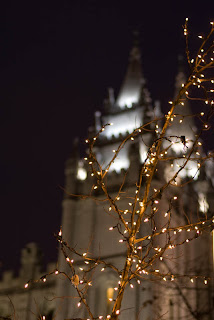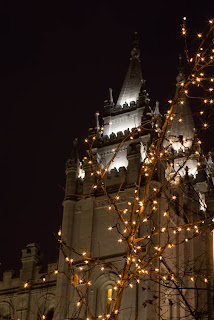Shutter Speed
We all remember what shutter speed affects right? Exactly, the amount of light and motion. So here are some shots of the base of the waterfall coming off the Conference Center. The thing we are watching here is the motion of the water.This shot was taken at a shutter speed of 20. Remember your shutter speeds are usually really fractions of a second, so this is really 1/20 of a second. Not the fastest thing in the world, but hey it was dark outside what do you expect? Notice how this stopped the motion of the water because of the somewhat fast shutter speed. You can even see some of the splashing in this picture.

Now in contrast this shot was taken with a shutter speed of 6". Remember the "(double quotes) means seconds. This exposure was much longer than the first one. Notice how the water looks much more smooth and silky. This is usually the kind of look photographers like to get out of water, it gives you the feeling that the water is still moving.

Somethings to note, first, if you didn't remember this from the first lesson, these shots were exposed with the same amount of light. I took them one after the other. So the lighting conditions were pretty much exactly the same. Remember, the other thing the shutter speed controls other than motion is light. I left the shutter open a lot longer in the second shot, meaning a lot more light was hitting my sensor, this means something had to stop the light from coming in to get the same exposure, right? Well my aperture changed from a 1.4 in the first one, wide open for the lens I was using, to 16 in the second, almost all the way closed for that lens. So by adding more light with the shutter, I took away the same amount of light by closing the aperture. Second, I took these shots in time priority mode, meaning I just had to worry about setting my shutter speed and the camera picked the appropriate aperture for me to get the correct exposure.
Aperture
You probably already know what I'm going to ask, what does your aperture affect? Well just from reading the last part you should know that it affects the amount of light getting in, and of course the second thing is dof. Here are a couple of shots through the branch of a tree at the temple. So lets see how the dof changes between the two shots.First lets take a wide open aperture, of course the more open you are the lower the number? What, how does that work? Oh yeah, the aperture values are fractions too, why do they have to confuse us like that? This was taken at f2. The shutter speed was 20, just so you can see how it will have to change in the next picture to keep the correct exposure. Now the wider open we are the more shallow the dof, again with this backwards stuff, can't they just make it easier? So I focused on the tree in this shot and you can see how the temple is out of focus.

Now the same shot, this time I focused on the temple and changed my aperture to f11. For those of you watching for the shutter speed here it is, 1". Again we lost light by closing our aperture so we needed to get that light back by leaving our shutter open longer. If the wind would have been blowing you would have seen some blurry trails from the tree moving during that 1 second exposure. In this shot even though I focused on the temple the tree still looks to be in focus.

Practice Time
Okay now that you have read this, and seen some examples, and of course you understand it 100%, lets get some practice in. I was kidding about the 100%, but that is what the practice is for. I promise these things will get easier as you do them more. I was confused about which way thing went for a long time, but after doing it over and over again, it is just second nature now, and the same will happen for you. What I want you to do is take 4 pictures and send them to me. You can either email them to me or post them yourself and give me the link to them. I will either just look at them and email you back with comments I have, or I would prefer if you would let others see your shots too. I can either put them directly here or link to where you have them posted. That way we can all learn from each other. Don't worry about how interesting the shots look in this, they just need to show that we understand exposure. So you need to take 2 pictures to show motion, one with stopped motion and one with the motion still going. Then 2 pictures to show dof, one with a shallow dof, and one with a large dof.One suggestion about the dof, make sure things are kind of far apart from each other, this way they will definitely be on different planes and it will be easier to tell what you did. When I was first learning exposure I played with things in my house, so don't be afraid to do this. I had an object and took a picture making sure there was something against a far wall in the background when playing with the aperture. For the shutter speed I just took pictures of my ceiling fan. Remember these don't need to be professional pictures, they just need to show you understand exposure, and more importantly to give you practice.
Of course if you have any questions, or need some help setting up your shots don't hesitate to ask. Leaving a comment is probably the best way, so others can see your question and my answer as well, because, like you hear in school all the time, if you have the question somebody else probably does too. Have fun playing.


